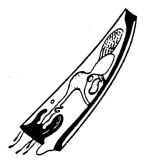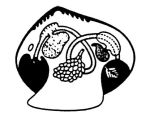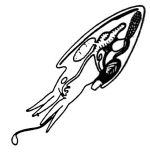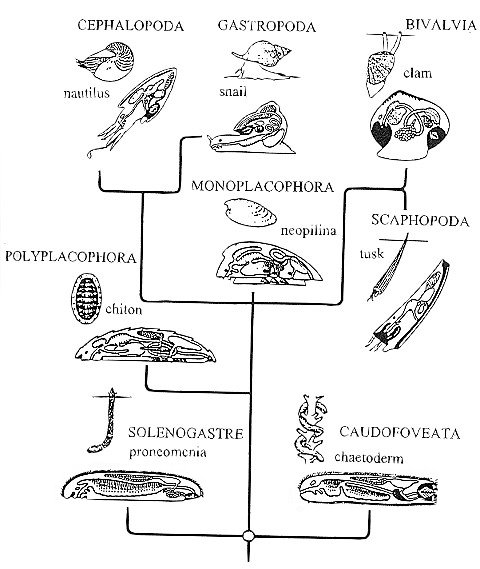中央研究院新闻 貝類的分類
Mollusks are a very diverse group of animals such as abalones, limpets, turbans, conchs, cowries, cones, snails, slugs, tusks, chitons, clams, mussels, scallops, oysters, venuses, squids, octopuses, cuttlefishes and nautilus. Although some groups are so modified that they no longer have a dorsal shell or a mantle cavity, all mollusks retain the basic head-foot-visceral mass morphology diagnostic of the Phylum Mollusca. The head carries out sensory and feeding functions. The foot is basically a muscular structure which functions as a locomotory organs. The visceral mass comprises the major internal organ systems: heart, gonads, kidneys, digestive system, etc. No unique characters define the entire Phylum Mollusca, which shows great structural and ecological variability, and members of the group can only be separated from other animals by the possession of a combination of characters (Beesley et al . 1998). Eight classes of living mollusks have been recognised. Also termed the Chaetodermomorpha, are worm-shaped, cylindrical, and covered by a cuticle and aragonitic scales. The posterior mantle cavity contains one pair of ctenidia. The ventral gliding area is reduced and lacks a distinct pedal groove. Chaetoderms burrow in marine muddy sediments, and feed on microorganisms. Or Neomeniomorpha, are worm-shaped and laterally compressed. The foot lies in a distinct ventral groove, the mantle has a cuticle bearing aragonitic scales or spicules, and the modified mantle cavity lacks ctenidia. These marine carnivores are epibenthic or epizoic on cnidarians, on which they feed. Proneomenia was collected from the South China Sea. Chiton or coat of mail shells have a flattened body and a broad foot, a mantle covered with cuticle and spicules or scales and a shell of eight valves. The shell valves bear sensory papillae or aesthetes. Most chitons are grazing herbivores, some feed on colonial organisms, such as sponges, and one group captures small prey. Class Polyplacophora Monoplacophora are covered with a cap-shaped shell. The peripedal mantle cavity supports five to six pairs of modified ctenidia. There are five to six pairs of excretory organs. The animals are marine detritus feeders, attached to hard substrata. The living fossil, Neopilina galatheae (Lemche, 1957) was discovered in 1952 (Lemche and Wingstrand 1959). The tusk shells are conchiferans in which the mantle is fused mid-ventrally and the tubular shell is open at both ends. Thead bears a long snout and two groups of slender tentacles, termed captacula, and the foot is cylindrical and pointed. These marine micro-carnivores burrow in sediment. Bivalves are laterally compressed conchiferans covered with a shell composed of two valves jointed dorsally by a ligament. The mantle cavity surrounding the body contains a single pair of enlarged ctenidia, and the posterior mantle is often extended into siphons. They are benthic, often burrowing, or may be epiphytic and they occupy a wide variety of marine and freshwater habitats. In all gastropods, including snails, slugs and limpets, the mantle cavity is rotated from its posterior position during the developmental process of torsion, so that it comes to be at the anterior end. Gastropods use a wide variety of feeding methods and occur in many types of terrestrial, freshwater and marine habitats, including the pelagic zone. This class is by far the largest group of Mollusca. Class Gastropoda They are conchiferans with a dorso-ventrally elongated body. When present, the shell is coiled to straight, typically chambered such as Nautilus . The head is free, and bears a pair of eyes, and one or two circles of eight to ten (or up to about 90 in Nautilus ) tentacles surrounding the mouth. The foot is modified as a funnel for jet propulsion. A rectal ink sac provides fluid used in defence. Among these marine, benthic or pelagic carnivores are the largest mollusks, with body sizes up to 20m . The phylogenetic tree of Phylum Mollusca. Class Caudofoveata ![]()
Class Solenogastre ![]()
![]()
Class Monoplacophora 
Class Scaphopoda 
Clasas Bivalvia 

Class Cephalopoda 
(modified from Salvini-Plawen and Steiner, 1996) 

